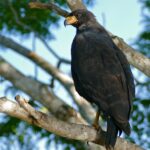Great Black Hawks, scientifically known as Buteogallus urubitinga, are a species of large raptor found in Central and South America. These impressive birds of prey are known for their striking black plumage and impressive hunting skills. However, one question that often arises is whether these majestic birds possess teeth in their beaks.
Do Great Black Hawks Have Teeth?
No, Great Black Hawks do not have teeth in their beaks. Like most birds, they rely on their specialized beak structure and adaptations to capture, tear, and consume their prey.
The Evolution of Beaks in Birds
 Image source: Great Black Hawk by Bernard DUPONT
Image source: Great Black Hawk by Bernard DUPONT
The evolution of beaks in birds is a fascinating process that has occurred over millions of years. Birds are descendants of theropod dinosaurs, many of which had sharp, serrated teeth. Over time, birds underwent significant transformations in their oral anatomy, replacing teeth with beaks for more efficient and specialized feeding strategies.
Beak Adaptations of the Great Black Hawk
The Great Black Hawk’s beak is specifically adapted to its dietary needs. Its hooked, sharp beak is designed to tear flesh and grasp prey, while its sharp, curved talons are used to catch and hold onto its targets. The beak serves as a ‘knife’ to cut their food into manageable pieces, making it easier for them to consume and digest.
Feeding Habits of the Great Black Hawk
Great Black Hawks are opportunistic predators, feeding on a variety of prey, including:
- Mammals (such as small rodents and rabbits)
- Birds (including other smaller birds)
- Fish
- Crabs
- Reptiles (such as snakes and lizards)
Their diverse diet allows them to thrive in a variety of habitats, from tropical forests to wetlands and coastal areas.
Beak Structure and Function
The Great Black Hawk’s beak is composed of a hard, keratin-based material, similar to human fingernails. This structure provides the necessary strength and sharpness for tearing and manipulating their prey. The hooked shape of the beak is particularly useful for ripping and tearing flesh, while the sharp tip allows them to pierce and grasp their targets.
Comparison to Other Raptors
While Great Black Hawks do not have teeth, many other raptor species, such as eagles, hawks, and falcons, also lack traditional teeth. Instead, they rely on their specialized beaks and talons to capture, kill, and consume their prey. This adaptation has allowed these birds to become highly efficient predators, capable of thriving in a wide range of environments.
Importance of Beak Adaptations
The evolution of beaks in birds has been a crucial factor in their success and diversification. Beaks allow birds to exploit a wide range of food sources, from seeds and insects to small mammals and fish. By adapting their beak structure to their specific dietary needs, birds have been able to occupy a variety of ecological niches, contributing to their overall success as a group.
Conclusion
In conclusion, Great Black Hawks, like most birds, do not have teeth in their beaks. Instead, they have evolved specialized beak structures and adaptations that allow them to capture, tear, and consume their prey effectively. This adaptation, along with their impressive hunting skills and diverse diet, has enabled the Great Black Hawk to thrive as a successful predator in its natural habitats.
Reference:
– Great Black Hawk (Buteogallus urubitinga) – Birds of the World
– Evolution of Beaks in Birds – National Geographic
– Raptor Beak Adaptations – The Peregrine Fund


